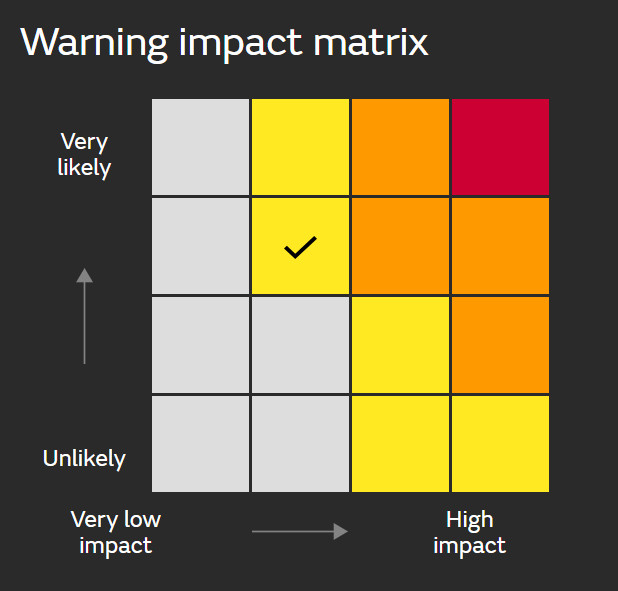Weather can be highly-changeable and sometimes severe, posing risks to life, property, and daily activities.
The Met Office plays a crucial role in mitigating these risks by issuing weather warnings through the National Severe Weather Warning Service (NSWWS). These warnings are designed to inform the public, businesses, emergency responders, and governments about impending severe weather and its potential impacts.
Why the Met Office issues weather warnings
The primary purpose of weather warnings is to alert people to severe weather conditions that could disrupt daily life and pose safety hazards. By providing timely and accurate warnings, the Met Office helps individuals and organisations take necessary precautions to minimise the impact of severe weather. This proactive approach is essential for public safety, as it allows people to prepare for and respond to adverse weather conditions effectively.
READ MORE: Find out the lastest information from the UK Storm Centre
Types of weather warnings
The Met Office issues warnings for various weather conditions, including rain, thunderstorms, wind, snow, lightning, ice, extreme heat, and fog. These warnings are color-coded (yellow, amber, or red) based on the severity of the weather and the likelihood of its impacts. Each warning includes the following sections:
- Headline: A brief statement indicating the type of weather expected.
- What to Expect: Details on the potential impacts and their likelihood.
- What Should I Do: Advice and guidance on how to stay safe during severe weather.
- Further Details: Additional information about the forecast and any updates to the warning.
The color-coding system
The color-coded system helps convey the severity and likelihood of weather impacts:
- Yellow Warnings: Indicate potential impacts and advise people to check the forecast and take precautions.
- Amber Warnings: Suggest more significant and widespread impacts, urging people to change plans and protect themselves and their property.
- Red Warnings: Reserved for the most severe weather, indicating a high risk to life and substantial disruption. People are advised to take immediate action to stay safe.

READ MORE: Check out our weather warnings guide
Factors Considered in Issuing Warnings
When issuing weather warnings, the Met Office considers several factors to assess the potential impacts:
- Time of Year: Seasonal variations can affect the severity of weather impacts.
- Time of Day: Weather conditions during rush hour can have more significant impacts.
- Location: Different regions may have varying levels of preparedness for certain weather conditions.
- Local Events: Outdoor events or activities can increase the risk of weather impacts.
- Ongoing Sensitivities: Existing vulnerabilities in an area, such as saturated ground or weakened structures, can exacerbate weather impacts.
Impact-based warnings
Since 2011, the Met Office has adopted an impact-based warning system. This means that warnings are issued based on the potential impacts of the weather rather than specific weather thresholds. This approach considers various factors, such as the time of day, time of year, and the region's familiarity with the weather conditions. For example, strong winds in winter may not warrant a warning, but the same winds in summer, when people are camping, could lead to a warning due to the higher risk of impact.
Impact tables
The Met Office uses impact tables to illustrate the types of impacts that different weather conditions can cause. These tables provide a guide to the expected impacts at low, medium, and high levels. The tables cover various weather conditions, including rain, thunderstorms, wind, snow, lightning, ice, extreme heat, and fog. They help people understand the potential consequences of severe weather and take appropriate actions.
READ MORE: What are the National Severe Weather Warning Service Impact tables?
What to do when a warning is issued
When a weather warning is issued, it is essential to take it seriously and prepare accordingly:
- Yellow Warnings: Check the forecast details and take steps to minimise impacts.
- Amber Warnings: Change plans that could be affected by the weather and take protective actions.
- Red Warnings: Take immediate action to stay safe, as there is a high risk to life and significant disruption.
The Met Office's weather warnings are a vital tool for safeguarding the public and minimising the impacts of severe weather. By understanding how and why these warnings are issued, individuals and organisations can better prepare for adverse weather conditions and protect themselves and their communities. Stay informed, stay safe, and make the most of the weather, whatever it may bring.
Keep up to date with weather warnings, and you can find the latest forecast on our website, on YouTube, by following us on X and Facebook, as well as on our mobile app which is available for iPhone from the App store and for Android from the Google Play store.


